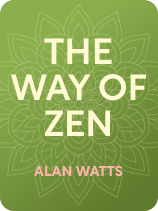

This article is an excerpt from the Shortform book guide to "The Way of Zen" by Alan Watts. Shortform has the world's best summaries and analyses of books you should be reading.
Like this article? Sign up for a free trial here.
Where did Zen come from? What ideas did Zen borrow from Taoism, Confucianism, and Mahayana Buddhism?
Zen created a synthesis of Chinese and Indian traditions. It continues to be practiced by millions of people around the world today. To find the origins of Zen Buddhism, we must go back to sixth-century China.
Keep reading to learn how Zen Buddhism got its start in a culture already rich with ideas.
The Origins of Zen Buddhism
According to Watts, the traditional origin story of Zen credits a monk named Bodhidharma with introducing many of the ideas that would become Zen Buddhism. The story goes that Bodhidharma arrived in China from India in the year 520 and spent nine years meditating in a cave at a monastery in Wei. There, he became the first patriarch of Zen.
Several other monks also played important roles in the origins of Zen Buddhism. Seng-chao, a copyist of Confucianist and Taoist texts, read a Mahayana Buddhist text that explained that awakening could be experienced in everyday life. He went on to produce writings of his own, explaining Buddhism in terms of Taoism and forging a link between Taoism and Zen. Similarly, a monk named Tao-sheng seems to be the first to have taught that awakening can be instantaneous.
(Shortform note: Bodhidharma, Seng-chao, and Tao-sheng are often cited as significant Zen Buddhist figures. In The Zen Experience, Thomas Hoover characterizes Seng-chao as a pre-Zen Buddhist who began integrating Taoism and Buddhism into what would become Zen. Hoover also explains that Tao-sheng is often cited in connection with two ideas: first, that good deeds don’t necessarily bring a reward; and second, that enlightenment is instantaneous. As for Bodhidharma, Hoover points out that though we don’t know the full teachings of the first patriarch of Zen, it’s believed that he promoted the use of meditation, sutras, and Buddhist rituals as tools for awakening to your true nature.)
Watts explains that, ultimately, Zen was created as a “way of liberation” to undo the effects of the conventions that we learn in society—effects such as indecision, anxiety, and self-consciousness. Zen created a synthesis of Chinese and Indian traditions, and, after its origin in China, it spread outward, most notably to Japan.
(Shortform note: Though psychological experiences like indecision and anxiety have many interrelated causes, the ideas of Zen might be able to help. Dialectical Behavior Therapy (DBT), an evidence-based psychotherapy that was developed for individuals with borderline personality disorder but is also an empirically validated treatment for anxiety, explicitly draws on the Zen idea of the synthesis of “opposites” to help people manage their distress and live more mindfully.)
What Ideas Did Zen Borrow?
Zen and its ideas can be traced back to three schools of thought: Taoism, Confucianism, and Mahayana Buddhism. Taoism and Confucianism are Chinese forms of thought and religion, while Mahayana Buddhism is an Indian school of Buddhism. Each contributed ideas that would become foundational to Zen Buddhist teachings about life and enlightenment. We’ll outline which ideas Watts identifies as having made the most crucial contributions to the development of Zen. Those ideas concern the nature of our perception, awakening, and our actions in the world.
(Shortform note: Though the word “awakening” appears throughout The Way of Zen, Watts doesn’t explicitly define it. But in a TV program called “Buddhism and Science” that Watts recorded in 1960, he offers a succinct description. He explains awakening as a sudden realization that the good and the bad—the positive and the negative—in life are one. When you experience awakening, you understand that these phenomena are inseparable from one another and that one is necessary for the existence of the other.)
Confucianism
Confucianism influenced Zen indirectly by affecting the organization of ancient Chinese society. Watts explains that Confucianism is humanistic: It creates a social order focused on harmony, ethics, and communication by teaching people to follow social convention. When Confucianism absorbed Buddhist practices, this interweaving of ideas led to an attainable way for the average person—who has work, family obligations, and interests—to practice Buddhism and to experience awakening. By contrast, other forms of Buddhism teach that attaining awakening would take lifetimes of effort across multiple cycles of reincarnation.
(Shortform note: Confucianism is a belief system that focuses on personal ethics and morality. These are achieved through the virtue of “humanity” and expressed in respect, humility, and altruism. Confucianism concerns itself with the ethical interactions among people and entities, not with spiritual matters. Philosopher D.T. Suzuki, a major influence on Watts, writes in Zen and Japanese Culture that Zen emerged as a Chinese response to Indian thought as reflected by Buddhism, so Zen necessarily reflects the practicality and ethics of Confucianism.)
Taoism
A second school of thought that shaped Zen Buddhism is Taoism, which proposes what Watts calls a liberation from Confucianism. Whereas Confucianism emphasizes the importance of ethics and social conventions, Taoism aims to help people see those conventions for what they are: socially agreed-upon meanings and values rather than something real or concrete. Taoism proposes that realizing the true nature of these conventions enables us to step back from them and experience life in harmony with the universe as it actually exists.
Two ideas of Taoism became foundational to Zen Buddhism: the idea that we can experience two different kinds of knowledge and the idea that we can act spontaneously in the moment.
There Are Two Ways of Knowing
First, the Taoist idea that there are two kinds of knowledge—conventional and unconventional—deeply influenced Zen. Conventional knowledge is contingent on socially agreed-upon meanings and value judgments. Watts writes that these are culturally defined and have to be represented in language (or other forms of notation, like mathematical equations). Facts, labels, and definitions are conventional knowledge.
On the other hand, unconventional knowledge doesn’t rely on the abstractions of language and representation. Instead, it gets directly at the experience of the actual world. When you’re walking under an oak tree, you might feel its shade, take in the scent of its leaves, and watch the movement of its branches. Your experience of observing it without naming or describing it is unconventional knowledge. We often assume that we can’t “know” something unless we can express it in language. But Taoism proposes that unconventional knowledge enables us to know the world directly, by experiencing it.
We Can Act Spontaneously and Naturally
Another idea that’s foundational to Zen comes from the Taoist principle wu-wei, the experience of making decisions naturally and spontaneously. Watts writes that when you let your mind decide how to act, it moves more naturally and intelligently—not impulsively, but out of the spontaneity of the moment. This leads to the experience of wu-hsin, translated as “no mind,” a kind of “un-self-consciousness” that you can experience when you let your mind work without trying to direct it or interfere with it. You can develop te, or “virtue,” a creative ability that you can only access by acting naturally and spontaneously.
Watts traces this logic a step further and explains that not only can you act spontaneously, but there’s no other way you can behave. If you realize that even your intentions, purposeful actions, and voluntary decisions arise spontaneously from your natural self (the self that you actually experience, rather than the abstract idea of yourself), then you can stop trying to be spontaneous or worrying that you aren’t.
Mahayana Buddhism
A third school of thought that shaped Zen Buddhism is Mahayana Buddhism, which reframes the pursuit of nirvana, the traditional Buddhist idea of release from karma and cycles of death and rebirth. Mahayana takes the idea of this cycle figuratively, explaining that the pursuit of nirvana is futile and we’re continually reborn from moment to moment until we stop trying to escape what’s really happening in the present moment.
Two ideas from Mahayana Buddhism had a major impact on Zen: the idea that we don’t perceive the world as it really is and the idea that there’s nothing for us to attain in life.
We Don’t Perceive the Real World
Important to Zen is Mahayana Buddhism’s teaching that illusions obscure your perception of the world. Watts explains that the principle of maya is that the language we use to describe the world obscures what it really is. Maya is about relativity: We name things like “light” and “darkness” or “good” and “evil” and consider them opposites. But, in reality, they aren’t separate. Watts explains that Hindus and Buddhists refer to the world as “nondual” rather than as “one” because even the concept of “one” draws on a false duality (it’s conceptually opposite to “many”). Letting go of the impulse to name and delineate things enables you to perceive the relativity and impermanence of the world and experience moksha, a “liberation” from maya.
It follows from the principles of maya and moksha that language also curtails what you can understand of yourself. Watts writes that in all forms of Buddhism, you can’t apprehend your true self because there’s no permanent or unchanging self to understand. He points out that what you think of as your self or ego is just an abstraction. Your true self eludes your understanding if you hold onto that abstraction.
There’s Nothing to Pursue or Attain, Not Even Nirvana
Another Mahayana idea that’s foundational to Zen is the doctrine that there’s nothing for us to grasp at, even nirvana. (One of the Four Noble Truths of Buddhism is nirvana, which Watts characterizes as analogous to moksha. Nirvana is a state of awakening.) When we seek things, we fail to see that everything exists in a state of relativity, where nothing exists except in relation to other things.
The origin of this idea is unclear. Watts writes that some scholars think that one of the earliest ideas of Mahayana Buddhism was that one could be a Bodhisattva and reach enlightenment by foregoing nirvana until all beings can experience it. But Watts argues that the idea underlying the Bodhisattva is implicit in the logic of Buddhism: Nirvana is a state you reach when you stop trying to grasp reality. But, if there’s nothing to grasp, then how is there anything to attain?
The word tathata, often translated as “suchness,” represents the true state of all beings, including Buddhas, people who have experienced awakening. That means that all beings can become Buddhas. It also means that by letting go of the abstractions through which you usually see the world and yourself, you can experience the world in its “suchness.” Watts explains that the use of a word like “suchness” to describe the true nature of all beings is intended to remind us that while “meaning” is a quality of thought or language, it doesn’t exist in the actual world. In other words, the idea of a person is separate from the reality of the person.
What’s Different About Zen Buddhism?
While Zen was built on what came before, it’s a unique school of Mahayana Buddhism with many original ideas. The most important differences between Zen Buddhism and other schools of Buddhism are its directness (in awakening and in teaching), its stance on meditation, and its principles about how you should use your mind.

———End of Preview———
Like what you just read? Read the rest of the world's best book summary and analysis of Alan Watts's "The Way of Zen" at Shortform.
Here's what you'll find in our full The Way of Zen summary:
- The major principles and history of Zen Buddhism
- How to experience Zen in everyday life—without a strict meditation practice
- Why calling Zen a "practice" is a mistake






